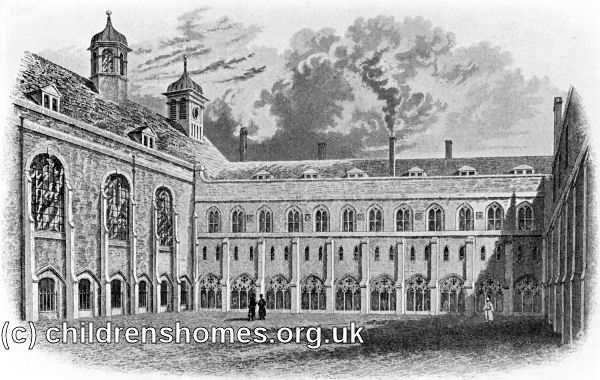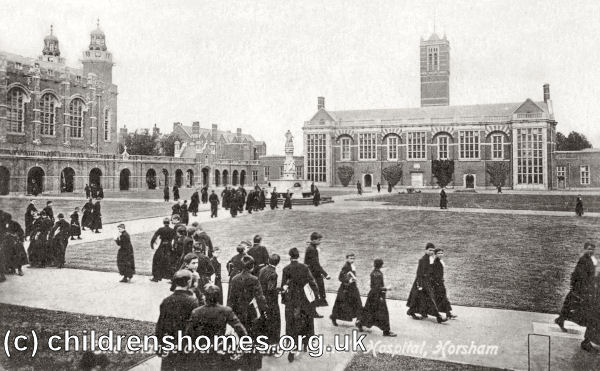Christ's Hospital, London
Christ's Hospital, which might claim to have been England's first institutional home for poor or orphan children, was located on London's Newgate Street, a little way to the north of St Paul's Cathedral. In 1546, the former Greyfriars monastery, closed by Henry VIII's dissolution of the country's religious houses, was given by the King to the City of London to be used for relief of the poor. Four years later, after hearing an impassioned sermon by the Bishop of London, Nicholas Ridley, about the plight of London's poor, the young Edward VI confirmed his father's gift and also provided the institution with an annual endowment of £600. He commissioned the Lord Mayor of London, Sir Richard Dodd, to take the matter forward and raise further funds for its operation. By November 1552, the buildings had been refurbished and 340 poor, fatherless children were admitted into what then became known as Christ's Hospital. The term 'hospital' at that time signified a place of refuge rather than a medical facility.
The uniform adopted for the Hospital's inmates comprised a black cap, a long blue gown with a red belt, and yellow stockings. The colours were chosen for very practical reasons: blue was the colour of a cheap dye often used for the clothing of servants and apprentices, while yellow was believed to discourage lice. The institution became informally known as the Blue Coat School, and its outfit was subsequently copied by other institutions that modelled themselves on Christ's, such as Queen Elizabeth's Hospital in Bristol (founded 1586), the Blue Coat School in Canterbury (1574), Lincoln Christ's Hospital School (1614), the Blue School in Wells (1641), the Reading Blue Coat School (1646) and Chetham's Hospital in Manchester (1652).
Christ's was severely damaged in the Great Fire of London. Many were housed in temporary accommodation in Hertfordshire and in 1682 a satellite boarding-school was established in Hertford. The rebuilding of the Newgate Street premises was completed in 1705 to designs by Sir Christopher Wren.

Christ's Hospital, London. © Peter Higginbotham

The Old Hall and Library at Christ's Hospital, London. © Peter Higginbotham
A further major rebuilding took place from 1793 to 1836, including a Grammar School completed in 1793, a new Great Hall in 1829, Grammar and Mathematical Schools in 1834 and the cloisters known as the Grecians Cloister in 1836.
By the eighteenth century, the original London establishment was no longer housing the poorest children, but was boarding and educating 'the orphans of the lower clergy, officers and indigent gentlemen as could secure nomination by a member of the governing body'.
In the 1880s, the object of the establishment was stated as 'to educate, maintain, and clothe boys and girls'. Admission was chiefly by nomination of governors. City Aldermen as ex-officio governors have a nomination annually; donation or private governors one about every third or fourth year. Candidates were required to be between 8 and 10 years of age, free from disease or any physical defect which would render them unable to take care of themselves, and to be truly needy. A written statement was required showing the source and amount of income, total number of children in the family, how many were still young and dependent, and any other relevant circumstances. Certificates of parents' marriage and child's birth and baptism were also required. Admissions take place at the meetings of governors in February, March, April, May, June, July, September October, and November. All children were required to be examined and approved by the Hospital's medical officers, and to pass an examination as to their attainments. The Hospital particularly requested that parents who were in no real need of assistance from a charitable foundation like this Hospital would 'refrain from importuning the governors for presentations or seeking the admission of their children into the Hospital.' The boys were admitted first at Hertford, and subsequently transferred to London. There were large sums available for apprenticing them, and many valuable exhibitions to the universities. In 1890, the Hospital's inmates comprised around 1100 boys and 90 girls.

Quadrangle at Christ's Hospital, London, 1890s. © Peter Higginbotham

Dining Hall at Christ's Hospital, London, 1890s. © Peter Higginbotham
In 1902, the school moved to new premises near Horsham, Sussex, where it continues to the present day as an independent co-educational school.

Changeover Quadrangle at Christ's Hospital, Horsham. © Peter Higginbotham

Laying tables in dining-hall at Christ's Hospital, Horsham. © Peter Higginbotham
Records
Note: many repositories impose a closure period of up to 100 years for records identifying individuals. Before travelling a long distance, always check that the records you want to consult will be available.
- Christ's Hospital Museum, Christ's Hospital Museum, Horsham, Sussex RH13 0YP. Tel: 01403-211293. Visitors by appointment only.
Bibliography
Links
Except where indicated, this page () © Peter Higginbotham. Contents may not be reproduced without permission.


